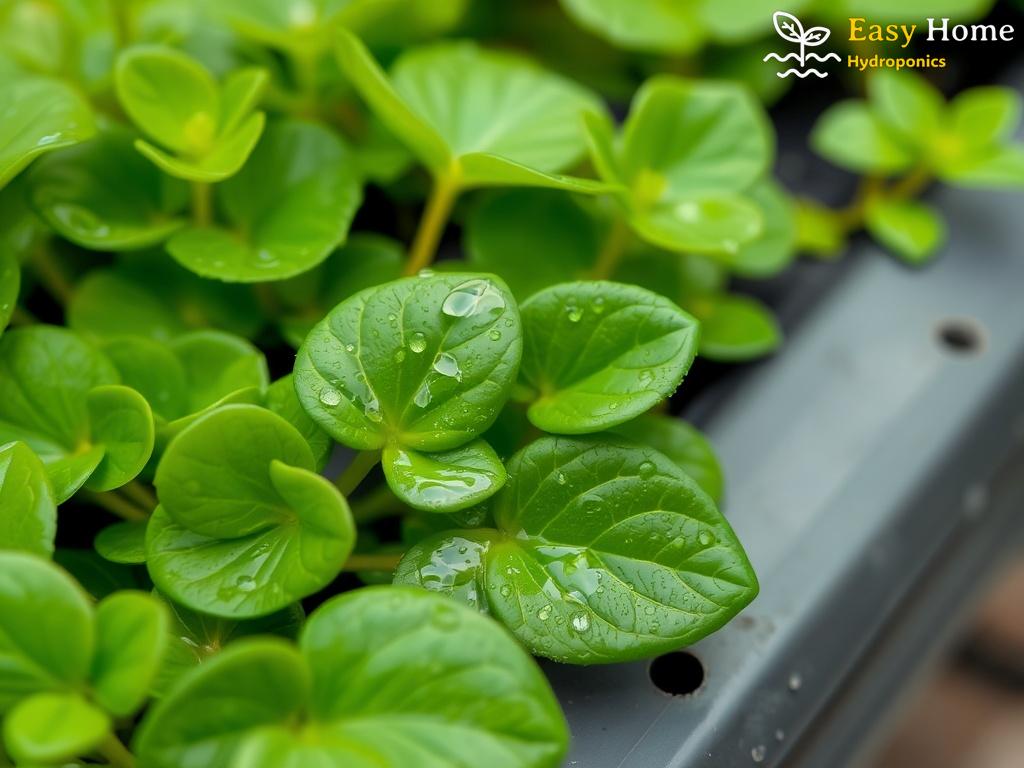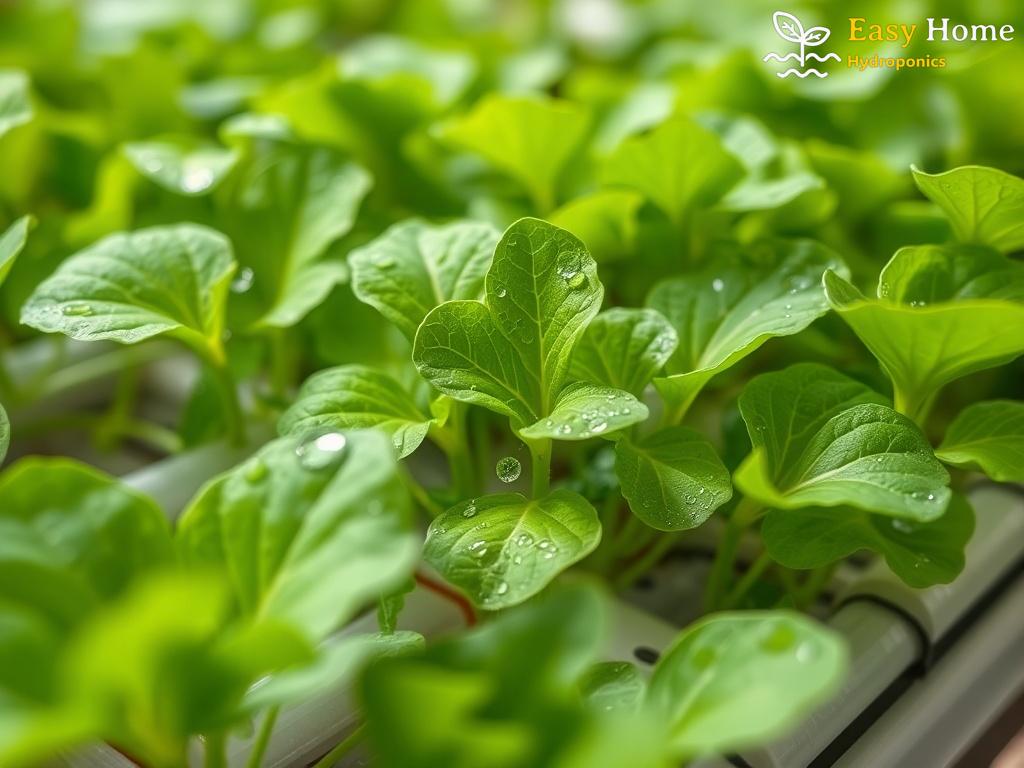The Hidden Nutritional Power of Purslane
Unveiling the Green Gold
Purslane, often dismissed as a mere weed, is making waves in the culinary world for its astonishing nutritional profile. This succulent green, with its tender leaves and slightly tangy flavor, is not just a garden intruder but a powerhouse packed with essential nutrients. As consumers increasingly turn towards health-conscious eating, the spotlight is on this unassuming plant that thrives in hydroponic systems.
A Nutritional Comparison: Purslane vs. Traditional Greens
When it comes to nutrient density, purslane stands out against traditional leafy greens like spinach and kale. Below is a comparison that highlights the extraordinary benefits of incorporating purslane into your diet.
| Nutrient | Purslane (100g) | Spinach (100g) | Kale (100g) |
|---|---|---|---|
| Omega-3 Fatty Acids | 0.2g | 0.1g | 0.1g |
| Vitamin C | 21mg | 28mg | 120mg |
| Calcium | 65mg | 99mg | 150mg |
| Iron | 1.99mg | 2.71mg | 1.47mg |
This table illustrates that while purslane may not always be the frontrunner in every category, it excels in providing a unique blend of nutrients, particularly omega-3 fatty acids, which are crucial for heart health and reducing inflammation.
From Weeds to Gourmet Delicacies
The transformation of purslane from a neglected weed to a sought-after gourmet ingredient is a testament to the evolving food landscape. Chefs and home cooks alike are now recognizing its versatility, incorporating it into salads, soups, and even smoothies. Its crisp texture and slightly lemony flavor can elevate a dish while adding a nutritional punch.
In conclusion, embracing purslane not only supports a healthy lifestyle but also champions sustainable eating practices. When cultivated hydroponically, this green marvel flourishes with minimal environmental impact, making it a smart choice for health enthusiasts and environmentally conscious consumers alike.
Hydroponic Techniques for Growing Purslane
As the culinary world embraces the nutrient-packed benefits of purslane, the method of cultivation is equally important. Hydroponic techniques provide an innovative way to grow this green gem, ensuring optimal conditions for its growth while maximizing its nutritional value. This method not only allows for year-round cultivation but also enables growers to control the environment, resulting in a cleaner and more sustainable product.
Understanding Hydroponic Systems
Hydroponic systems can be categorized into several types, each offering unique benefits for growing purslane. From nutrient film techniques to deep water culture, understanding the intricacies of these systems is essential for successful cultivation. Hydroponics eliminates the need for soil, instead relying on nutrient-rich water that can be tailored to the specific needs of purslane, promoting robust growth and flavor.
Essential Steps for Hydroponic Purslane Cultivation
Growing purslane hydroponically involves several key steps that ensure a bountiful harvest:
- Choosing the Right System: Select a hydroponic system that suits your space and resources, such as a nutrient film technique (NFT) or aeroponics.
- Setting Up the Environment: Maintain optimal temperature (around 65-75°F), humidity, and light exposure (12-16 hours of light daily) to mimic purslane’s natural habitat.
- Nutrient Solution Preparation: Utilize a balanced nutrient solution rich in potassium, nitrogen, and phosphorus, crucial for leafy greens.
- Monitoring Growth: Regularly check pH levels (ideally between 5.5-6.5) and adjust nutrient concentrations to support healthy growth.
- Harvesting: Harvest purslane when the leaves are tender and vibrant, ensuring the best flavor and nutritional profile.
The Future of Hydroponic Purslane
With the growing trend of health-conscious eating, hydroponically grown purslane is poised to become a staple in gourmet kitchens and health food stores alike. As more people recognize the versatility and benefits of this once-overlooked plant, its demand will likely rise. By mastering hydroponic techniques, growers can contribute to a sustainable future while providing consumers with a nutrient-dense option that tantalizes the taste buds.
Culinary Uses: Elevating Purslane in Gourmet Dishes
As the culinary world continues to explore innovative ingredients, purslane has emerged as a vibrant player in the gourmet arena. Chefs are now actively incorporating this humble green into their dishes, transforming it from a common weed into a celebrated ingredient. With its unique flavor profile and impressive nutritional benefits, purslane is becoming a staple on menus that prioritize health and creativity.
Transformative Flavor Pairings
Purslane’s slightly tangy and lemony taste makes it an excellent companion for a variety of dishes. In salads, it adds a refreshing crunch that complements other greens, fruits, and proteins beautifully. Imagine a summer salad bursting with heirloom tomatoes, fresh mozzarella, and a generous handful of purslane drizzled with a balsamic reduction. The combination not only tantalizes the taste buds but also showcases the vibrant colors of the ingredients, making it a feast for the eyes.
But purslane’s culinary potential extends beyond salads. It can be used in soups and stews, where its succulent leaves become tender and flavorful, enriching the broth. Incorporating purslane into a classic vegetable soup not only elevates the dish but also infuses it with heart-healthy omega-3 fatty acids. Chefs are discovering that this versatile green can seamlessly transition from a garnish to a star ingredient, enhancing both flavor and nutrition.
Creative Culinary Techniques
Beyond traditional cooking methods, purslane is making waves in gourmet presentations. Chefs are experimenting with techniques like pickling and blending to highlight its unique properties. Pickled purslane can add a zesty kick to tacos or charcuterie boards, while blended purslane can serve as a vibrant green base for sauces or dressings, providing a nutrient boost without compromising flavor.
Furthermore, the use of purslane in smoothies and juices is gaining traction among health enthusiasts. Its high antioxidant content and refreshing taste make it an ideal addition to blended beverages, ensuring that consumers can enjoy its benefits in a convenient form. Whether it’s a revitalizing green smoothie or a cleansing juice, purslane’s culinary versatility encourages people to explore new and exciting ways to incorporate it into their daily diets.
As the interest in hydroponic cultivation grows, so does the opportunity to experiment with this remarkable plant. Purslane is not just a garnish; it is a testament to how we can elevate humble ingredients into gourmet experiences. By embracing this nutrient-dense green, chefs and home cooks alike are not only enhancing their dishes but also advocating for sustainable, health-conscious eating.
Environmental Benefits of Hydroponic Purslane Cultivation
The rise of hydroponic systems has revolutionized the way we think about agriculture, particularly with the cultivation of nutrient-dense greens like purslane. As we delve deeper into the environmental advantages of hydroponic purslane, we uncover how this innovative farming technique not only yields a healthier product but also contributes positively to our planet. This unique approach minimizes land use, conserves water, and reduces the carbon footprint associated with traditional farming methods, making it a sustainable choice for future generations.
Soil-less Sustainability: A New Era for Agriculture
Hydroponic cultivation eliminates the need for soil, which is one of the first steps toward a more sustainable agricultural practice. By growing purslane in nutrient-rich water solutions, we can produce food in urban environments, effectively utilizing vertical space and reducing the dependence on arable land. This shift is crucial as urbanization continues to encroach on valuable agricultural areas, leading to soil degradation and loss of biodiversity. Purslane, thriving in hydroponic systems, can be grown in urban settings, providing fresh produce to city dwellers while minimizing the overall ecological footprint.
Water Conservation: A Precious Resource Saved
Water scarcity is becoming a pressing global issue, and traditional farming practices often waste copious amounts of this precious resource. Hydroponic systems are designed to use significantly less water than conventional methods, as they recirculate water and nutrients, ensuring that every drop counts. For instance, hydroponic cultivation can use up to 90% less water compared to traditional soil farming. This remarkable efficiency not only helps conserve water but also mitigates the impact of agriculture on local water sources, preserving ecosystems and their inhabitants.
Furthermore, the closed-loop nature of hydroponic systems minimizes runoff, reducing the risk of chemical fertilizers and pesticides contaminating nearby water bodies. This contributes to a healthier ecosystem, allowing aquatic life to thrive without the threat of polluted waters. By adopting hydroponic practices for growing purslane, we are actively participating in a movement towards cleaner, safer farming.
Carbon Footprint Reduction: A Greener Alternative
Transporting food from rural farms to urban centers contributes significantly to greenhouse gas emissions. Hydroponic purslane cultivation can take place within city limits, drastically cutting down on the carbon footprint associated with transportation. Fresh, local produce can be delivered in minutes rather than days, ensuring that consumers have access to the highest quality greens while supporting local economies.
Moreover, hydroponic systems can be powered by renewable energy sources, further reducing their environmental impact. Integrating solar panels or wind turbines into these systems can make them self-sufficient, allowing for an even greener approach to agriculture. The future of food production is not only about health and nutrition; it is also about sustainability and environmental responsibility.
The transition to hydroponic cultivation of purslane exemplifies how innovative agricultural techniques can address pressing environmental challenges. By embracing this method, we champion a future where nutrient-dense foods are accessible, sustainable, and produced with minimal environmental impact. As consumers increasingly demand healthier and more environmentally friendly options, hydroponic purslane stands out as a beacon of hope for both our diets and our planet.
Purslane: From Weed to Superfood Trend
Redefining Perceptions: The Rise of Purslane
Purslane, once viewed as an unwanted garden intruder, is now capturing the attention of health enthusiasts and gourmet chefs alike. This vibrant green, rich in nutrients and flavor, is experiencing a renaissance as the culinary world embraces its unique qualities. As consumers become more aware of their food choices, the demand for nutrient-dense ingredients has skyrocketed, propelling purslane into the spotlight. Its transition from a humble weed to a sought-after superfood is not just a trend; it represents a broader shift towards healthy, sustainable eating.
The Nutritional Goldmine of Purslane
What makes purslane stand out in the crowded field of superfoods? This seemingly ordinary plant is an extraordinary source of vital nutrients that are often lacking in modern diets. From potent antioxidants to essential fatty acids, purslane boasts a remarkable profile that can benefit overall health. Here’s a quick look at what this green powerhouse brings to the table:
- Omega-3 Fatty Acids: Purslane is one of the few plant sources rich in omega-3s, essential for heart health.
- Vitamins and Minerals: Packed with vitamin C, magnesium, potassium, and iron, it supports various bodily functions.
- Antioxidants: The abundance of antioxidants in purslane helps combat oxidative stress, reducing the risk of chronic diseases.
- Low in Calories: With a low caloric density, it’s a perfect addition to weight management diets.
Integration into Modern Cuisine
With its vibrant color and unique flavor, purslane is not just a garnish; it’s quickly becoming a star ingredient in various culinary creations. Innovative chefs are incorporating it into diverse dishes—from salads and smoothies to soups and gourmet entrees. Its adaptability allows it to complement a range of flavors, making it a favorite for those looking to elevate their meals. The transformation of purslane from a neglected weed to a culinary delight is a testament to its versatility and nutritional prowess.
As the superfood trend continues to grow, pursuing a diet rich in diverse greens like purslane is a delicious way to embrace health and wellness. The journey of purslane from the garden to gourmet kitchens exemplifies how we can redefine our understanding of food, turning overlooked ingredients into prized culinary treasures.




